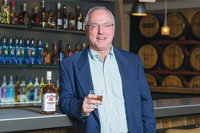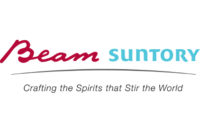Beam Global Spirits & Wine Shares Its New World View

Beam Global Spirits & Wine Shares Its New World View
BY SARAH THEODORE
The World Looks Like a Very Different Place Than it did a Year ago for Beam Global Spirits & Wine. This Month Marks the One-year Anniversary Since the Deerfield, Ill.-based Company Acquired More Than 20 new Brands From Allied Domecq and Pernod Ricard, Nearly Doubling Both the Size of the Company and its International Presence.
“This is a very exciting time in the evolution
of our company,” says Beam Global President and Chief Executive
Officer Tom Flocco. “It’s the biggest thing we’ve ever
done as a company and a massive transformation of this organization.”
The company, best known for its flagship Jim Beam
bourbon brand, spent $5.2 billion last year to purchase brands such as
Sauza tequila, Courvoisier cognac, Canadian Club whisky, Maker’s Mark
bourbon, Laphroaig Scotch whisky, and Clos du Bois, William Hill and Buena
Vista wines, which were made available when France’s Pernod Ricard
acquired the U.K.’s Allied Domecq. The move made Beam the
fourth-largest spirits firm in the world, added 18 million cases globally,
and doubled its annual sales to $2.5 billion. It also changed its
international exposure from a quarter of its business to nearly half,
reducing its reliance on any one market in the world. To recognize its new
international scope, the company changed its name early this year from Jim
Beam Brands Worldwide to Beam Global Spirits & Wine Inc.
“We realized that there were opportunities in
this industry to expand our footprint as it relates to categories,
geographies and the people that we have in the organization,” Flocco
says. “We saw Allied as a terrific opportunity to add in all those
areas — to enhance our category portfolio, expand our geographic
reach and balance inside and outside the United States … and to bring
some terrific people around the world into the organization.”
But the expanded geography is probably “the
piece that feels the most different to the organization,” he says.
Beam’s main markets previously consisted of the United States,
Australia and New Zealand; today it counts six or seven countries among its
most important, including the United Kingdom, Mexico, Spain and Germany.
“If I look at the way we are today vs. the way
we were 18 months ago, there’s a huge difference in the amount of
time people spend outside the countries they reside in and that’s a
dramatic difference,” Flocco says. “There’s a cultural
component to it as well. We’re not as U.S.-centric anymore. We have
to adapt to other cultures around the world.”
That cultural awareness applies to differences within
the company’s own operations and to the perception of its brands
among distributors and consumers around the world. The company says
consumers in all of its markets are shifting to premium alcohol products,
which makes its newly expanded lineup all the more relevant, and it has
developed strategies for making sure brand messages are consistent from
market to market.
“We custom designed the structure of our
marketing function to meet the needs of our new global strategy that
emerged as a result of the acquisition,” says Beth Bronner, senior
vice president and global chief marketing officer. This structure is
pivotal to ensuring that brand communications are consistent around the
world, she says. “If a loyal fan of Jim Beam travels to Europe,
they’ll see consistencies with how the brand is portrayed; it
shouldn’t mean one thing in country and another thing somewhere
else,” Bronner says.
“Before, we were a marketing-led function. Now
we are a brand-led function. In short, that means we build teams around
brands, not around geographies.“
The resulting collaboration between brand team members
has been one of the biggest benefits of the acquisition, Bronner says.
Local markets execute locally against core brand strategies. In the U.S.
and Mexico that happens through Jim Clerkin, senior vice president and
president, North America, and through national and regional marketing and
sales teams. Throughout the rest of the world, it happens via Donard
Gaynor, senior vice president and managing director, international, and
sales teams located in individual markets around the world.
“Beam Global is making an enormous effort to
have these global brands with these wonderful equities, but execute locally
for the consumer in those markets,” says Clerkin, who joined the
company from the previous Allied Domecq organization, where he served as
president, Allied Domecq Spirits, North America.
“The marketing team works very hard to
understand consumers and consumer needs in every country in the world
… and then my team will look at the nuances within each
marketplace,” he says. “The consumer in Wisconsin, for example,
has a different pattern of consumption than they have in Florida. We try to
capture those nuances and differences. It’s a much-abused phrase, but
we do like to think globally and then act locally.”
The expanded brand portfolio has given the company a
big boost with distributors. “In conjunction with our sales arm
Future Brands LLC, and our joint-venture partner, The Absolut Spirits Co.,
we’ve solidified our position as the second-largest spirits company
by volume in the United States,” Clerkin adds.
“What this acquisition has done is taken [the
company] to new levels in terms of how we are considered by our distributor
partners and our retailers,” he says. “It’s put Beam in a
very different position in that, we’ve added 4 million cases of
volume — that’s an easy thing to do — but what
we’ve added has real value. These are premium and super-premium
brands.”
While the company has been the longtime leader in the
bourbon category with top-seller Jim Beam, it had gaps in segments such as
tequila and cognac. Today, it considers its core lineup to be Jim Beam,
Courvoisier, Sauza, Maker’s Mark, Canadian Club, Laphroaig and
Starbuck’s Liqueur. Both Sauza and Canadian Club hold the No. 2
positions in their respective categories.
The company now also carries a number of national
brands that give it a strong local presence in each market. “Not only
did we buy big global brands, but we also bought some very strong national
brands,” Flocco says. “Larios Gin, for example, in Spain.
That’s an important market for us, so we picked up Larios. We did the
same thing in Germany and the United Kingdom and in many markets that were
big priorities for us. We picked up brands that gave us critical mass in
those markets.”
National brands in the portfolio include DeKuyper
cordials and liqueurs in the United States, DYC whisky and Fundador brandy
in Spain, Harveys Bristol Cream sherry, Cockburn’s port and
Teacher’s whisky in the United Kingdom, and Kuemmerling bitters in
Germany.
In addition, the company also has what it calls
“promise brands,” the products it considers to have the
greatest untapped potential. Knob Creek bourbon, successful upstart
Starbucks Coffee Liqueur and even the well-established Maker’s Mark
are included among the promise brands.
“Even though Maker’s is coming up on
700,000 cases, it is still a promise brand because it has an opportunity to
really blow the doors off of the bourbon category,” Flocco says.
Superstar brand
Starbucks liqueur hit more than 100,000 cases in sales in its first year on
the market, and was designated by ACNielsen as one of the top-selling new
products of 2005 in overall dollar sales.
“We have an icon in the branding of this,”
Clerkin says. “It’s probably the best-known coffee brand in the
world, and it was very successful in its first year.”
According to the company, Starbucks contributed to
more than half of the coffee liqueur category’s 7 percent growth in
2005, and early this year, it added Starbucks Cream Liqueur to the line.
Laphroaig Scotch whisky, the world’s No. 1
single malt Islay whisky, is a lesser-known brand, but one the company has
high hopes for. It was named winner of the Distiller of the Year Award at
this year’s San Francisco World Spirits Competition. The brand walked
away with five double-gold awards, and Clerkin says, “That’s as
good as it gets.”
As it completes its first year since the acquisition,
Beam Global says the integration of brands and people into the company is
an ongoing process. In addition to Clerkin joining the Beam Global
executive team, Bill Newlands, president of Beam Wine Estates, also came
over after serving as president and chief executive officer of Allied
Domecq Wines North America, and Ian Gourlay took over as senior vice
president of operations and supply chain at Beam Global from his position
as senior vice president of global operations at Allied.
Flocco says the company finds itself in a somewhat
easier position this year as it outlines its plans for 2007 with all of the
brands under roof, which the timing of the acquisition did not allow last
year. “This is the first year that the brands are going together,
with a whole different way of working and with a whole different cast of
people around the table,” he says.
“We have an organization that is much stronger
than the sum of its parts,” he adds. “In this environment where
you have ongoing consolidation of retailers, distributors and suppliers,
that strength is critical … To think that we’ve covered what we
have as an organization in a year is just mind-boggling.” BI
Team player
Beam Global has developed joint ventures to sell and distribute its brands in
the United States and abroad. The company established Future Brands LLC
with the Absolut Spirits Co. in 2001 to handle sales and distribution in
the United States for Beam’s brands as well as Absolut Vodka and
Plymouth Gin. Maxxium Worldwide was created in 1999 through a collaboration
with Beam, the Edrington Group, Remy Cointreau and the V&S Group
(Absolut). It provides sales and distribution for the four companies in
most major international markets but does not represent Teachers, Laphroaig
and Courvoisier, which have alternative distribution solutions globally.
The company says the
brands acquired last July from Allied Domecq and Pernod Ricard will more
than double case volume internationally, and increase case volume in the
U.S. by about 20 percent. Combined, case volume increased from 18 million
cases to 37 million cases worldwide.
‘Leading edge’ marketing
Beam Global has strong ties to racing, sponsoring cars in both the
Indy Racing League and NASCAR. The company calls Jim Beam “The
Official Spirit of Racing,” and introduced its newly acquired
Canadian Club brand to racing this year. The company marked its
participation in both series with the Beam 1100, a promotion that sent a
consumer to both the Indy 500 in Indianapolis, and the 600 at Lowe’s
Motor Speedway in Charlotte, N.C., in the same day. The winner watched Jim
Beam-sponsored Michael Andretti and Canadian Club-sponsored Dario
Franchitti in Indianapolis, and then was flown by private jet to Charlotte
to see Robby Gordon race under the sponsorship
of Jim Beam Black.
The company uses the racing partnerships and its racing
spokesmen to promote its Drink Smart responsibility campaign, which
includes donations to the Century Council’s Alcohol 101 Plus
university education program.
“We’re very proud of our participation in
racing and the way we demonstrate an understanding of social
responsibilities,” says Beth Bronner, global senior vice president
and global chief marketing officer. “I think it says so much about
the kinds of leading-edge marketing that we’re about.”
Looking for a reprint of this article?
From high-res PDFs to custom plaques, order your copy today!






